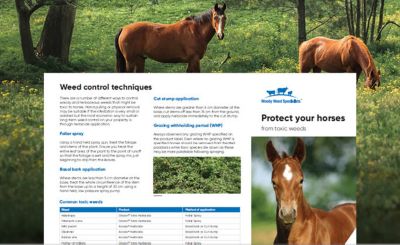Access®
- Herbicide
group
- 1
Specialised product for robust control of almost any woody weed via the cut stump or basal bark application technique. Access offers a solution for very targeted woody weed control in environmentally sensitive situations.
Features
Formulation
Targeted Weed Control
Through the specialised application techiques, provides targeted weed control with minimal off-target risk.
Basal bark treatment
Cut Stump Treatment
Crops
See full label for details.
Woody Weeds Infestations
Technical Specifications
-
Active Ingredient240 g/L Triclopyr, 120 g/L Picloram
-
Application Method
Basal bark, cut stump and thinline applications
-
Mode of ActionPlant cell growth disruption
-
FormulationsOL
-
Packaging1 L and 5 L
-
Group
Group 1
Target Weeds
|
|
See Access Label for full list of weed species..
Application
Equipment required for application
- Suitable knapsack or small pressure pump spray unit.
- Measuring jug.
- Cotton overalls or long-sleeved shirt and long trousers.
- Washable hat.
- Elbow-length neoprene gloves.
- Safety glasses or face shield.
Mixing
Only mix Access with diesel or Biosafe. Never mix Access with water.
Quarter fill the spray unit with diesel or Biosafe then add the Access. Complete the filling with diesel or Biosafe and agitate well.
Only mix enough Access for each day’s work and use the mix within 24 hours.
Application timing
Access is most effective when applied to weeds that are not stressed due to lack of moisture, excessive heat, previous herbicide treatment, etc. and are actively growing. Actively growing weeds will draw the chemical into the vascular system and transport it down to the roots to ensure maximum efficacy. Provided the target weeds are not stressed, application of Access via either treatment method can occur throughout the year.
To ensure maximum penetration, do not apply an Access mix to charcoal-coated or wet stems as this will compromise penetration and minimise efficacy.
Application Methods - Basal Bark
Both the basal bark and cut stump application methods should be applied at very low pressures from the knapsack and the nozzle adjusted to very coarse, to a point where the mixture will stream/dribble out and not spray or mist.
Basal bark application
Using a knapsack or small pressure sprayer, apply the spray mix to the stems or trunk of the target weed from the ground up to a height of 30 cm (the base, hence basal bark). Ensure that the entire circumference of the stems or trunk is treated.
Ensure that the sprayed surface is wet to the point of run-off. Where possible, ensure buds at or below the soil surface are treated.
For weeds with multiple stems, ensure each one is treated around the entire circumference.
Basal bark treatment is generally effective when weed stems are up to 5 cm in diameter. When stem diameter exceeds 5 cm, a cut stump application is recommended.
Application Methods - Cut Stump
Both the basal bark and cut stump application methods should be applied at very low pressures from the knapsack and the nozzle adjusted to very coarse, to a point where the mixture will stream/dribble out and not spray or mist
First, cut the tree/sapling leaving an exposed stump. Ideally the cut stump surface will be horizontal to the ground to prevent chemical run-off. Using a knapsack or small pressure sprayer, apply the spray mix to the cut surface of the trunk, the sides of the stump and any roots above the soil surface.
It is important that the spray mix be applied immediately after the stem is cut to maximise the penetration into the stump.
Ensure that the sprayed surfaces are thoroughly wet..
Application Methods - ThinLine technique
The ThinLine™ technique, where a more concentrated mixture is applied to the bottom 5 cm only, can be considered for some species. Some woody weeds can be treated when basal diameter is greater than 5 cm. Refer to the product label for details.
Stewardship
Safety to stock
Access herbicide poses little risk to stock and the application method means that there is no stock grazing withholding period. This means that stock do not need to be removed from paddocks during treatment.
Off-target damage
Many desirable crops and ornamentals are very sensitive to Access so care must be taken when applying the product to avoid contact with desirable plants.
Plants susceptible to Access include (but are not limited to) fruit trees, grape vines, legumes (pea, beans, lucerne, etc.), potatoes, roses, shade trees and tomatoes.
Residues
Residues of Access herbicide can remain active in the soil for many months, with the longevity affected by use rate, soil type, temperature and moisture. Care therefore needs to be taken when planting new crops or trees into areas where Access has been applied to ensure that no residues remain active.
Cleaning spray equipment
After spraying is complete, thoroughly clean the spray unit to ensure no residues remain that may cause damage to desirable plants when the equipment is next used. After completion of spraying use a degreaser such as Caltex Kwik-D-Grease® to remove traces of diesel from the sprayer, rinse the tank and spray through nozzles thoroughly with water to remove the degreaser.
After the above, wash the tank, hoses and nozzles with a mix of water and an alkaline laundry detergent such as Omo® or Drive®. Shake the water around in the sprayer and spray the solution through the nozzle to thoroughly clean the lines and nozzle. Rinse well with water to remove the detergent.
If Access and diesel are applied as a cut stump using a brush and pot, spray liberally with degreaser, hose off thoroughly and repeat using detergents as above.
Ensure rinse water is disposed onto a designated area or an unused area where there is no risk to desirable plants.
More...

Woody Weed Control Guide
The Woody Weed Control Guide is the essential handbook for controlling woody weeds on your property. It contains everything you need to know about what herbicide to use on what weed and is updated each year with the latest weed control knowledge to ensure that you can stay up to date with the most effective ways to manage weeds on your property.
View now
Grazon Extra Herbicide
Grazon Extra is primarily used for brushweed control plus difficult to control broadleaf weeds in fallow situations in northern Australia. In Southern Australia it is the standard for volunteer lucerne removal prior to cereal cropping.
Product details
Starane Advanced Herbicide
Starane Advanced is a broadleaf herbicide used for the control of a wide range of weeds in winter cereals as well as woody weeds in agricultural noncrop areas.
Product details